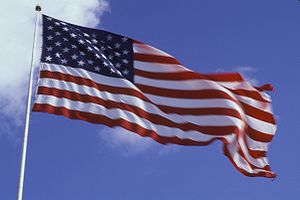United States Flag Code
 From Conservapedia
From Conservapedia 
The United States Flag Code (title 4, chapter 1 of the United States Code) is a federal law which describes the official appearance of the Flag of the United States and how it should be handled. The US Flag Code is purely descriptive, and does not include any provisions for enforcement outside of the District of Columbia.
In addition, the US Flag Code codifies the Pledge of Allegiance.
Contents
- 1 The Code's rules and standards
- 1.1 Appearance of the flag
- 1.2 Handling the flag
- 1.2.1 Defacement and misuse of the flag
- 1.2.2 Proper disposal of the flag
- 1.2.3 Other restrictions
- 1.3 Pledge of Allegiance
- 2 History
- 3 Notes and references
- 4 External links
The Code's rules and standards[edit]
Appearance of the flag[edit]
Section one and two describe the official appearance of the US flag. Section one of the Code describes the flag as "thirteen horizontal stripes, alternate red and white," with a union of "forty-eight stars, white in a blue field." The code, which was passed into law on 22 December, 1942 (as Public Law 77-826; chapter 806) before the 1959 incorporation of Alaska and Hawaii as the 49th and 50th states, also makes provisions for updating the flag in section two, adding new stars for new states on the following fourth of July.
Handling the flag[edit]
Section three describes how not to handle the flag, and sections five through nine describe how to handle, display, store, and respect the flag.
Defacement and misuse of the flag[edit]
Section 3 is describes how the US flag should not be handled, misused, or defaced.
While the bulk of the code is purely descriptive, violating section 3 within the District of Columbia carries a penalty of "a fine not exceeding $100 or by imprisonment for not more than thirty days, or both, in the discretion of the court." There is much controversy concerning misuse and abuse of the US flag, and violation of this law is seldom prosecuted.
Proper disposal of the flag[edit]
Section 8 states that the flag, when it has reached a condition that it is no longer a fitting emblem for display (e.g. damaged or torn beyond repair) it should be destroyed in a dignified way that respects the flag. The preferred method stated in the code is burning, and associations such as the American Legion[1] hold flag disposal ceremonies, often on Flag Day.
Other restrictions[edit]
The code also stipulates:
- Section g: *The flag should never have placed upon it, nor on any part of it, nor attached to it any mark, insignia, letter, word, figure, design, picture, or drawing of any nature.
- Section i: The flag should never be used for advertising purposes in any manner whatsoever.
Note: for examples of the above see the conservapedia logo in the top left.
Pledge of Allegiance[edit]
Section 4 describes the Pledge of Allegiance, both codifying its text and describing proper conduct during the Pledge of Allegiance. People in military uniform should silently salute the flag, while other people should remove any non-religious headgear, and face the flag with their right hand over their heart.
History[edit]
Notes and references[edit]
- ↑ American Legion flag disposal ceremony
External links[edit]
- The text of Title 4 of the United States Code, Chapter 1
- USHistory.org on handling and treatment of the US Flag
↧ Download as ZWI file | Last modified: 02/03/2023 14:26:33 | 36 views
☰ Source: https://www.conservapedia.com/United_States_Flag_Code | License: CC BY-SA 3.0
 ZWI signed:
ZWI signed: KSF
KSF